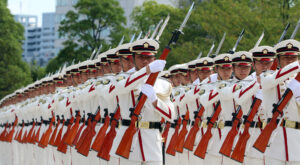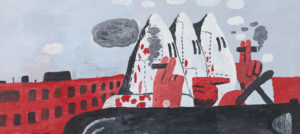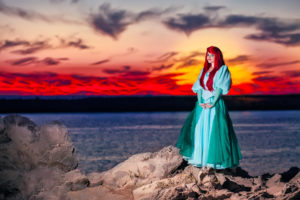Before the internet, the only way for an American teen to watch anime was illicitly, on bootlegged video cassettes that were passed fan to fan like some visual drug. Each new discovery felt like a tiny revelation, a step into an undiscovered country. The distant realm of Japan was a place I only knew about from my grandfather’s war tales and dark stories on the evening news.
The Eighties was an era of trade frictions between Japan and the West, of bellicose political rhetoric and literal Japan-bashing: American lawmakers gleefully took sledgehammers to Japanese electronics on the steps of Congress. But my friends and I were not deterred, enchanted as we were by animated fantasies so strikingly different from anything in our own culture. And even then, we could tell that there was something different about a certain anime auteur. His name was Hayao Miyazaki.
It is the rare creator who possesses the knack of appealing simultaneously to casual moviegoers, die-hard genre fans and tastemakers alike. Miyazaki’s latest film, The Boy and the Heron, set records when it was released in Japan this year; this weekend, it made history as the first original anime movie to reach number 1 in both American and Canadian cinemas. Influential international devotees include Wes Anderson and Guillermo Del Toro, who took David Cronenberg to a screening of Miyazaki’s beloved ode to childhood, My Neighbor Totoro. And last year, a stage adaptation of Totoro premiered at the Barbican to so much acclaim that it has been revived already.
Miyazaki never set out to appeal to the outside world, let alone change it; he claims to be “baffled” by the popularity of his work abroad. Nevertheless, his films have captivated generations of foreign audiences — and transformed our view of Japan. The nation made itself rich by selling the world things, ranging from appliances to automobiles. But Japan made itself popular by selling us fantasies: anime, manga, Nintendo. Where my grandfather’s generation saw an aggressive foreign power, mine saw a factory of dreams.
Today, Japan is associated with cleanliness and order, but when anime was born, in the decades after the Second World War, the scars of conflict were everywhere and civil unrest commonplace. In 1960, millions of Japanese rallied to protest the Anpo, a military treaty with the United States that war-weary citizens fiercely opposed, for fear — justified, as it turned out — that it would drag their nation into America’s conflicts. The ruling party eventually railroaded it through parliament by forcibly ejecting politicians who dissented: a blatant rejection of democracy, which triggered demonstrations that would escalate into open violence over the course of the decade.
It was in this era that Miyazaki joined the ranks of Toei, then Japan’s biggest animation company, as a fresh university graduate. His career was minted mere months after anime itself: on the New Year’s Day that year, 1963, Japan’s first domestically produced, full-length animated television series, Mighty Atom, had debuted. Its creator, Osamu Tezuka, proudly described his work as anime, a contraction intended to distinguish it from imported animeshon, as imported foreign cartoons were known. Mighty Atom reminds us that protest runs in anime’s blood: the very first episode ends with a mass demonstration, as robots take to the streets to demand equality.
Across Japan, workers struggled against managers. Toei was no different. Miyazaki’s early years there were marked by low wages and unpaid overtime; he soon banded together with fellow animators in a labour union to protest. The vice president of the union, Isao Takahata, took a shine to the young Miyazaki, and recruited him to work on a new animated feature he was directing. Takahata aimed to jettison Toei’s established corporate structure in favour of making art on more democratic, even communal terms. The resulting film was a commercial failure; the partnership was a success.
Over the course of the Seventies, Miyazaki and Takahata, worked on a series of children’s shows. But manga and anime were evolving rapidly from kid’s stuff into something more, firing up a generation of young adults who were passionate about righting the wrongs of the world. Western authorities strictly regulated illustrated entertainment with measures such as “comics codes” and “comics campaign councils”. In Japan, artists were left to their own devices, allowing manga to emerge as a platform for delivering biting socio-political commentary, right under the noses of the establishment.
Japanese student demonstrators carried copies of manga Weekly Shōnen Magazine into their protests against the Vietnam War. And when members of the Japanese Red Army hijacked a passenger jet in 1970, they sent a missive claiming responsibility to the press that ended with the words “Never forget: we are Tomorrow’s Joe” — the name of a popular manga character who fights his way out of crushing poverty through boxing.
Miyazaki always claimed to eschew politics in favour of symbolism. “I have no interest whatsoever today in producing animation as part of an ‘art’ movement, in trying to bring attention to social issues, or in sending out messages,” he wrote in a 1985 essay for Japanese readers. “I want to create works that children can enjoy.” But the bite of his convictions, which bubble up in his works in quiet ways, is precisely what gives his films such power. It is impossible to ignore its ever-present anti-authoritarian bent.
It was an original feature film called Nausicaä of the Valley of Wind that served as Miyazaki’s breakthrough. Arriving in Japanese cinemas in 1984, it told the story of a young woman in a dystopian future, where Earth is now a toxic jungle, filled with poisonous air, towering fungi, and enormous insects. Fiefdoms of human survivors feud endlessly over what little habitable land remains. Miyazaki was not globally famous at this point, but Nausicaä was released abroad, albeit after being disastrously re-edited and censored.
Foreign anime fans sought out Nausicaä in its uncut, untranslated form. The coveted bootlegged VHS arrived in my parent’s basement towards the end of the Eighties, and even on a fuzzy cathode-ray tube screen, even without subtitles, the film proved revelatory. It is classic Miyazaki: a young female protagonist navigates a strange world; venal adult authority figures clash with young dreamers; the story gently guides the viewer to question class and power, war and peace. Here is a fundamentally countercultural Japanese worldview, expertly cloaked in artistic allegory. Watching this wild drama made it impossible for me or my friends to view Japan as an enemy or a rival. How could it be, when its fantasies spoke to us so deeply?
After Nausicaä, Miyazaki’s rise was meteoric, and inextricably linked to Studio Ghibli, which he co-founded in 1985. While rivals pursued lucrative corporate sponsorship, Studio Ghibli was self-funded, which gave it total creative control. Now, the studio’s reputation has reached such heights that it recently made the unthinkable decision not to promote The Boy and the Heron at all. Despite reportedly being one of the most expensive Japanese films ever made, Ghibli released no trailers, no print ads, no interviews, no press screenings, nothing at all save one cryptic poster. It had the biggest opening weekend in Studio Ghibli history.
But the flip side of total creative control was that neither Takahata nor Miyazaki could cede enough of it to anoint a successor. Takahata passed away in 2018, and Miyazaki, now 82, has announced and renounced his own retirement numerous times. Ghibli continues to flourish as a business, but its future remains uncertain: the closure of the production division was announced in 2014, only for it to be reopened long enough for Miyazaki to make The Boy and the Heron. That film’s stunning success has led to rumblings of another production in the works, but nothing concrete has been announced. Earlier this year, the studio sold a controlling stake to the Japanese television network NTV, ending nearly four decades of independence.
Ghibli’s concerns about its future mirror those of Japanese society as a whole. In the half-century since Miyazaki’s 1963 debut, Japan emerged as an economic superpower, before becoming a case study in stagnation. It is one of the oldest societies on the planet, Japan’s young people seem to see the world quite differently from Miyazaki’s; they are a minority, after all. They express less hope and less faith in their ability to affect meaningful political change, if multiple surveys are any indication.
Stagnation seems to have brought the dreams of anime down to Earth, too. New features focus less on changing the world than simply finding ways to survive in it — or escaping it altogether, as in the hugely popular genre of isekai, literally “other worlds”, where protagonists flummoxed by reality find meaning for themselves in fantasy realms. A demand for adventure has given way to a hunger for comfort and familiarity. Your Name became a hit in 2016 by cut-and-pasting a hodgepodge of anime clichés. It was set not in a vividly rendered imaginary world but a Tokyo so meticulously accurate that fans can use its scenes as a literal tourist map. Miyazaki, perhaps unsurprisingly, is notoriously ambivalent about the direction anime has taken in recent years, concerned that it has become narcissistic.
“I think that animated movies can relax, cheer and refresh,” he said in a 1983 interview. “And in so doing, they can help us escape from ourselves.” But through his work, Miyazaki has proven that anime is more than a form of entertainment; it can bridge cultures, and help young people understand and come to terms with the world in which they find themselves. We need it as much as we ever have — even though, or perhaps especially because, it feels harder to dream these days.
Disclaimer
Some of the posts we share are controversial and we do not necessarily agree with them in the whole extend. Sometimes we agree with the content or part of it but we do not agree with the narration or language. Nevertheless we find them somehow interesting, valuable and/or informative or we share them, because we strongly believe in freedom of speech, free press and journalism. We strongly encourage you to have a critical approach to all the content, do your own research and analysis to build your own opinion.
We would be glad to have your feedback.
Source: UnHerd Read the original article here: https://unherd.com/




